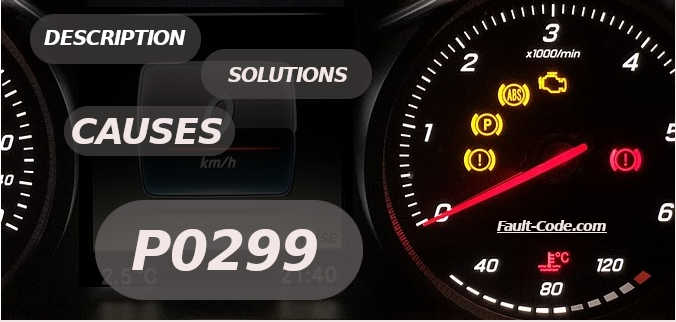OBD2 code P0299 Possible causes
If error code P0299 OBDII is set, it means that one or more of the following problems occurred:
- EGR system malfunction
- Low oil pressure
- Failure of the mechanical turbocharger
- Defective charge pressure sensor
- Defective turbocharger bypass valve, bleed valve or blast valve
- Disconnected, cracked or sunken vacuum lines (vacuum operated bypass valve)
- Disconnected or damaged turbocharger hoses
- Loose, corroded or disconnected electrical connections in the charge pressure sensor circuits
- Defective ECM or charge controller
When will P0299 be detected?
The engine control module (ECM) has detected an error between the expected and actual boost pressure.
What are the symptoms of code P0299?
- Reduced engine performance
- Irregular noises from the turbocharger’s throttle valve and/or ducts (more audible during acceleration)
- Heavy black smoke from exhaust
- Contaminated spark plugs
- Higher engine and/or gearbox temperatures
- Additional codes may also be stored, including other codes related to turbocharger recharging, engine ignition interruption codes or knock sensor codes
- Ignition loss is also possible due to higher engine temperatures.
What does code P0299 mean?
When code P0299 is displayed on a vehicle equipped with OBD-II, it means that the power unit control module (ECM) has detected a low turbocharger charge condition . This code may be caused by a mechanical or electrical fault in the forced air input (FAI) system.
Both the turbocharger and the compressor are forced air supply systems which are used to increase engine performance. Ambient air is sucked into any type of device, which then compresses the air and forces it into the engine combustion chambers. The main difference between a turbocharger and a compressor is the way they are driven. The turbocharger is driven by the engine exhaust coming out of the manifold. The compressor is driven by a belt that flows from the engine crankshaft. FAI systems usually use some kind of intercooler to make the air entering the engine even cooler and denser.
The charge controller is sometimes a stand-alone module, but is more often an integrated part of the ECM. Input data from different engine and gearbox sensors are used (by the controller) to determine how much boost pressure is required for the engine to operate at optimal levels. The actual boost pressure is then monitored to determine whether it meets the desired levels. The ECM compares the actual boost pressure with the required boost pressure and, if necessary, initiates by-pass control and/or blow-off valves.
Different bypass valves and pressure relief valves are used to regulate the charge pressure. Most are electronically activated, but there are several manufacturers that still use a vacuum driven design. Consult a reliable vehicle information source (such as All Data DIY) to know the specifications of the forced air induction control system (for your vehicle) before making a diagnosis. The powertrain and engine lubrication system must be in good condition before attempting to diagnose this code. If the ECM detects a charge pressure level that is below the programmed limit, code P0299 will be stored and the MIL lamp may light up.












